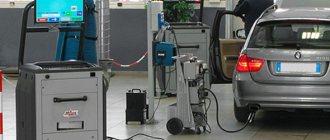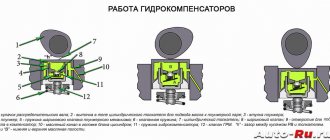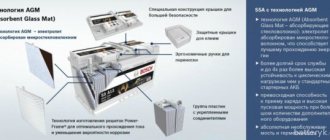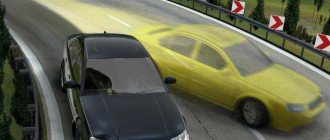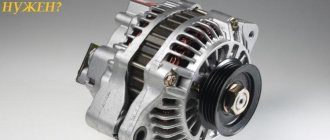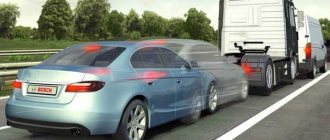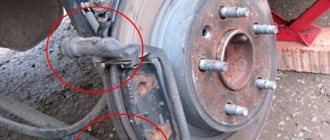Road traffic, in addition to the movement itself implied in the name, involves stopping. You brake at a traffic light, before a pedestrian crossing, in front of another car, and the like many times during a trip. Sometimes (usually more often than you would like) you have to stop very quickly and abruptly. There are 2 terms that need to be distinguished in this regard: braking distance and stopping distance. They mean different things, although they are interconnected by a common purpose: to show the driver that the laws of inertia apply to any car.
What is the braking distance of a car?
The braking distance is the distance that the car will travel after activating the brake system until it comes to a complete stop. This is only a technical parameter by which, in combination with other factors, the safety of the car is determined. This parameter does not include the driver's reaction speed.
_
The combination of the driver’s reaction to an emergency situation and the distance from the start of braking (the driver pressed the pedal) to the complete stop of the vehicle is called the stopping distance.
The traffic rules indicate critical parameters under which the operation of a vehicle is prohibited. The maximum limits are:
| Transport type: | Braking distance, m. |
| Motorcycle/moped | 7,5 |
| A car | 14,7 |
| Bus/truck weighing up to 12 tons | 18,3 |
| Truck weighing more than 12 tons | 19,5 |
Since the braking distance directly depends on the speed of the vehicle, the critical indicator is the distance covered by the vehicle mentioned above when the speed decreases from 30 km/h. (for motor vehicles) and 40 km/h. (for cars and buses) to zero.
A braking system that responds too slowly will always result in damage to the vehicle and often injury to those in it. For clarity: a car moving at a speed of 35 km/h will collide with an obstacle with a force identical to the impact of a fall from a five-meter height. If the speed of the car in a collision with an obstacle reaches 55 km/h, then the impact force will be identical to that of a fall from the third floor (90 km/h – a fall from the 9th floor, or from a height of 30 meters).
These research results show how important it is for a motorist to monitor the condition of the car’s braking system, as well as tire wear.
Approximate braking distance of a car: table
Every driver has at least once found himself literally a couple of seconds away from an accident when it is vitally important to have time to brake. However, the car cannot stand rooted to the spot on command. The distance that it travels from the moment it starts braking until it comes to a complete stop is called the braking distance. To be able to estimate the braking distance, you need to ensure that it is always less than the distance to the obstacle in the way.
The length of the braking distance depends on many different factors. This includes the driver’s reaction, the level of performance of the car’s braking system, and external factors, such as the track material and weather conditions. And of course, the speed of the car at the moment of braking plays a decisive role. The question arises - how to calculate the braking distance of a car under all these conditions? For general calculations, three main factors are sufficient - the braking coefficient (Ke), the speed of movement (V) and the coefficient of adhesion (Fs) with the road.
Formula for calculating the braking distance of a car
The formula from the table that calculates the braking distance looks like this: S=Ke*V*V/(254*Fs). The braking coefficient of a conventional light car is equal to one. The adhesion coefficient on a dry surface will be 0.7. For example, let's take the case when a car is moving on a dry road at a speed of 60 km/h. Then the braking distance will be equal to 1*60*60/(254*0.7)=20.25 meters. On ice (Fs=0.1) braking will last seven times longer - 141.7 meters!
Based on the result, we see how much the braking distance of a car from the table depends on the condition of the highway and weather conditions.
Braking in different conditions
The length of the braking distance is inversely proportional to the coefficient of adhesion to the road. Simply put, the worse the road holds, the longer the car slows down. Let's look at the changes in the coefficient (Fs) in more detail:
- with dry asphalt - 0.7;
- on wet asphalt - 0.4;
- if the snow is rolled - 0.2;
- icy road - 0.1.
What is the braking distance formula?
There are special formulas that help the driver calculate the braking distance during emergency and normal braking. Of course, they are averages.
So, normal braking involves gently pressing the brake pedal, for example at a traffic light. In this case, we are guided by the formula:
(Speed in km/h: 10) * (speed in km/h: 10) = braking distance in meters
That is, if you are moving at a speed of 50 km/h, the braking distance will be approximately 25 meters. We count like this: 50/10 * 50/10 = 5*5 = 25.
During emergency braking, the resulting value is divided by two more. The formula looks like this.
(Speed, in km/h: 10) * (speed, in km/h: 10) / 2
Let's do the math using a specific example. Let's say you are again moving at a speed of 50 km/h and a situation occurs in which you urgently need to brake. We calculate the braking distance as follows: 50/10 * 50/10 / 2 = 5 * 5/2 = 12.5 meters.
You may say that in an emergency there is no time to count and you need to act. Yes, you are absolutely right. But there is one “but”. Each driver moves around the city at approximately the same speed. Therefore, you can learn the desired value in advance and build on it when needed. This simple life hack could one day save someone's life. So take note of it.
What does the braking distance depend on and what formula can it be calculated by?
Braking distance is the distance it takes for a vehicle to come to a complete stop from the moment the braking system begins to operate.
In everyday life, this term is often confused with stopping distance, but braking distance and stopping distance are different concepts. In the latter case, the distance elapsed from the moment the driver realized the need to brake to a speed of 0 km/h is taken into account. The braking distance is part of the stopping distance.
What does braking distance depend on?
The indicator under consideration is not a constant value and can vary for a number of reasons. All factors influencing the braking distance can be divided into two large groups: driver-dependent and driver-independent. Reasons beyond the control of the person driving include:
- road condition;
- weather.
It is easy to guess that in rain, snow or ice, the distance required to stop a car will be greater than on dry asphalt. Braking will also take a long time when driving on smooth asphalt, to which stone chips have not been added. Here the wheels have nothing to catch on, unlike rough surfaces.
Note: it is worth noting that poor quality of the road (potholes, potholes) does not lead to an increase in the distance required to stop. The human factor plays a role here. Trying to save the suspension, drivers rarely reach high speeds on such roads. Accordingly, the braking distance here is minimal.
Factors depending on the driver or owner of the car:
- brake condition;
- system design;
- presence of ABS;
- type of tires;
- vehicle load;
- movement speed.
The fact that the length of a car’s braking distance directly depends on the serviceability of the braking system does not require proof. A car with a malfunctioning brake circuit or worn out pads will never be able to stop as quickly as a working vehicle.
A lot depends on the design of the brake units. Modern cars equipped with rear disc brakes and brake assist systems have much better traction and shorter braking times.
In turn, the presence of EBD with ABS does not always help reduce the distance required to stop. On dry hard surfaces, where wheel locking occurs only with very intense braking, the system actually shortens the braking distance. However, on bare ice, the “smart” electronic assistant begins to reduce braking force even when you lightly press the brake pedal. At the same time, the car retains controllability, but its braking distance increases significantly.
What determines the rate of deceleration? Of course, it depends on the type of tires. So, on bare, albeit frozen, asphalt, as well as in slushy snow, the so-called brakes are best. “Velcro” are winter tires that are not equipped with studs. In turn, in icy conditions and on snowy roads, studded tires are the most effective. An important factor influencing the size of the stopping distance is the speed and load of the machine.
It is clear that a lightweight car at a speed of 60 km/h will stop faster than a truck loaded to capacity and moving at a speed of 80-100 km/h. The latter will not be allowed to stop quickly by speed and inertia that is too high for him.
When and how measurements are taken
Braking distance calculations may be required in the following cases:
- technical testing of the vehicle;
- checking the capabilities of the car after modifying the brakes;
- forensic examination.
As a rule, the formula S=Ke*V*V/(254*Fs) is used in the calculation. Here S is the braking distance; Ke – braking coefficient; V₀ — speed at the start of braking; Фс – coefficient of adhesion to the coating.
The coefficient of road adhesion varies depending on the condition of the surface and is determined according to the following table:
State of the road Fs
| Dry | 0.7 |
| Wet | 0.4 |
| Snow | 0.2 |
| Ice | 0.1 |
The Ke coefficient is a static value and is unity for all the most common passenger vehicles.
Example: how to calculate the braking distance of a car when the speedometer shows 60 km/h in the rain? Given: speed 60 km/h, braking coefficient – 1, adhesion coefficient – 0.4. We count: 1*60*60/(254*0.4). As a result, we get the figure 35.4, which is the braking distance in meters.
The table shows how many meters the car will continue to move until it comes to a complete stop. It should be taken into account that no other indicators are taken into account (turns, potholes on the road, oncoming traffic, etc.). It is doubtful that in real conditions on an icy road, a car will be able to slide for a kilometer without encountering a pole or bump stop.
Speed Dry Rain Snow Ice km/h meters
| 60 | 20,2 | 35,4 | 70,8 | 141,7 |
| 70 | 27,5 | 48,2 | 96,4 | 192,9 |
| 80 | 35,9 | 62,9 | 125,9 | 251,9 |
| 90 | 45,5 | 79,7 | 159,4 | 318,8 |
| 100 | 56,2 | 98,4 | 196,8 | 393,7 |
| 110 | 68 | 119 | 238,1 | 476,3 |
| 120 | 80,9 | 141,7 | 283,4 | 566,9 |
| 130 | 95 | 166,3 | 332,6 | 665,3 |
| 140 | 110,2 | 192,9 | 385,8 | 771,6 |
| 150 | 126,5 | 221,4 | 442,9 | 885,8 |
| 160 | 143,9 | 251,9 | 503,9 | 1007,8 |
| 170 | 162,5 | 284,4 | 568,8 | 1137,7 |
| 180 | 182,2 | 318,8 | 637,7 | 1275,5 |
| 190 | 203 | 355,3 | 710,6 | 1421,2 |
| 200 | 224,9 | 393,7 | 787,4 | 1574,8 |
We found an interesting calculator that not only calculates the indicator depending on the speed and condition of the road, but also clearly shows the whole process. Located here.
How to increase the intensity of deceleration
From the above, it became clear what is called the braking distance and what this indicator depends on. However, is it possible to reduce the distance required to stop a car? Maybe! There are two ways to do this - behavioral and technical. Ideally, the driver combines both methods.
- Behavioral method - you can reduce the braking distance if you choose a low speed on slippery and wet roads, take into account the degree of load of the car, and correctly calculate the braking capabilities of the car depending on its condition and model year. Thus, a Moskvich developed in 1985 will not be able to brake as effectively as a modern Hyundai Solaris, not to mention more respectable and technologically advanced models.
- Technical method - a method of enhancing braking capabilities, based on increasing the power of the braking system and the use of auxiliary mechanisms. Manufacturers of modern vehicles actively use such methods of improving brakes, equipping their products with anti-lock braking systems, braking assistance systems, using more efficient brake discs and pads.
It should be remembered that reducing the time required to stop is one of the ways to ensure a safe trip. Therefore, every driver must constantly monitor the technical condition of his “iron horse”, promptly maintain and repair the braking system. In addition, it is important to choose the driving speed taking into account the surrounding situation: time of day, road condition, car model, etc.
znanieavto.ru
How to calculate the total stopping time and the final braking distance?
As we noted above, the driver needs time to make a decision to brake. That is, to react. Plus, it takes time to move your foot from the gas pedal to the brake pedal and for the car itself to react to this action.
There is a formula that averages out the driver's reaction path. Here she is:
(Speed in km/h: 10) * 3 = reaction distance in meters
Let's imagine the same situation. You are driving at a speed of 50 km/h and decide to brake smoothly. While you are making a decision, the car will travel 50/10*3 = 15 meters. We calculated the second value (the length of the actual braking distance) to be higher - 25 meters. As a result, 15+25 = 40. This is the distance your car will travel until you come to a complete stop.
What factors influence braking and stopping distance?
We already wrote above that the length of the braking distance is influenced by many factors. We invite you to consider them in more detail.
Speed
This is the key factor. This means not only the speed of the car, but also the reaction speed of the driver. It is believed that everyone has approximately the same reaction, but this is not entirely true. Driving experience, a person’s health status, medication use, etc. play a role. Also, many reckless drivers ignore the law and are distracted by smartphones while driving, which ultimately can lead to catastrophic consequences.
Remember one more important point. If a car's speed doubles, its braking distance quadruples! The 1:1 ratio doesn't work here.
Road conditions
Undoubtedly, the length of the brake line is influenced by the condition of the road surface. On an icy or wet road it can increase significantly. But these are not all the factors. You should also be wary of fallen leaves, on which tires glide perfectly, cracks in the surface, holes, and so on.
Tires
The quality and condition of the rubber greatly influence the length of the brake line. Often, more expensive tires provide better grip on the road surface. Please note that if the tread depth has worn off beyond the permissible value, then the rubber loses its ability to drain a sufficient amount of water when driving on a wet road. As a result, you may encounter such an unpleasant thing as hydroplaning - when the car loses traction and becomes completely uncontrollable.
To shorten the braking distance, it is recommended to maintain optimal tire pressure. Which one exactly - the automaker will answer this question for you. If the value deviates upward or downward, the braking line will increase.
Depending on the coefficient of adhesion of the tires to the road surface, this indicator will vary. Here is a comparative table of the dependence of the braking distance on the quality of the road surface (a passenger car whose tires have an average coefficient of adhesion):
| 60km/h. | 80 km/h. | 90 km/h. | |
| Dry asphalt, m. | 20,2 | 35,9 | 45,5 |
| Wet asphalt, m. | 35,4 | 62,9 | 79,7 |
| Snowy road, m. | 70,8 | 125,9 | 159,4 |
| Ice, m. | 141,7 | 251,9 | 318,8 |
Of course, these indicators are relative, but they clearly illustrate how important it is to monitor the condition of car tires.
Technical condition of the machine
A car can only go on the road in good condition - this is an axiom that does not require proof. To do this, carry out routine diagnostics of your car, make timely repairs and change the brake fluid.
Remember that worn brake rotors can double the brake line.
Distraction on the road
While the vehicle is moving, the driver has no right to be distracted from driving the vehicle and monitoring the traffic situation. Not only its safety, but the lives and health of passengers, as well as other road users, depend on this.
Here's what happens in a driver's brain when an emergency occurs:
- assessment of the road situation;
- making a decision - to brake or maneuver;
- response to the situation.
Depending on the driver's innate abilities, the average reaction speed ranges from 0.8 to 1.0 seconds. This setting concerns an emergency situation, rather than an almost automatic process when slowing down on a familiar stretch of road.
To many, this time period seems insignificant to pay attention to, but ignoring the danger can lead to fatal consequences. Here is a table of the relationship between the driver’s reaction and the distance traveled by the car:
| Vehicle speed, km/h. | Distance until the brake is pressed (the time remains the same - 1 second), m. |
| 60 | 17 |
| 80 | 22 |
| 100 | 28 |
As you can see, even a seemingly insignificant second of delay can lead to dire consequences. That’s why every motorist should never break the rule: “Don’t be distracted and stick to the speed limit!”
Various factors can distract the driver from driving:
- mobile phone - even just to see who is calling (when talking on the phone, the driver’s reaction is identical to the reaction of a person in a state of mild alcohol intoxication);
- watching a passing car nearby or enjoying beautiful scenery;
- fastening the seat belt;
- eating while driving;
- falling of an unsecured DVR or mobile phone;
- clarification of the relationship between driver and passenger.
In fact, it is impossible to make a complete list of all the factors that can distract a driver from driving. In view of this, everyone should be attentive to the road, and passengers will benefit from the habit of not distracting the driver from driving.
Calculating the braking distance of a motorcycle calculator
The braking distance calculator will allow you to estimate the braking distance of a car moving at a given speed. To use, specify the type of road surface on which the vehicle is braking and the speed at which braking begins.
The calculator will calculate how many meters the car will travel when braking.
Enter the initial data Type of road surface: Select road surface Dry asphalt Wet road Packed snow Icy road Speed, km/h FIND out total calculations - 6243 Formula for finding the braking distance The formula for finding the braking distance is used in the traffic police departments. This is what is used in our calculator. In this formula: S is the braking distance, Kt is the braking coefficient (for a passenger car it is equal to 1), V is the vehicle speed, Ksc is the adhesion coefficient.
It is influenced by:
- condition and type of road surface,
- car tire condition,
- initial speed of the car,
- vehicle weight,
- serviceability of the brake system.
Stopping distance is the distance from the moment the danger is detected until the vehicle comes to a complete stop.
In addition, the stopping route includes:
- the distance traveled by the car from the moment the danger was detected until the brake pedal was pressed;
- the distance traveled by the vehicle during the braking system activation.
The first parameter depends on many factors, the determining one of which is the driver’s reaction time.
According to the results of numerous experiments, it can vary from 0.3 to 1.5 seconds.
On average, the driver's reaction time can be considered to be 1 second. In addition, there is the concept of “normative time for perceiving a complex situation” equal to 0.8 seconds.
It has also been established that the reaction time for women when a difficult traffic situation arises can reach 2.5-3 seconds, while for men it is 1.5-2 seconds.
In addition, the reaction time is affected by:
- driver experience,
- his emotional state
- age,
- time of day and weather conditions,
- taking medications,
- state of alcoholic or other intoxication,
- the location of the hazardous situation.
The response time of the brake system depends on its type and technical condition. The brake system with a hydraulic drive operates in 0.2 - 0.3 seconds, with a pneumatic drive in 0.5 -0.6 seconds.
Your rating[ 33 Average: 4.7] Author admin average rating 4.7/5 — 33 user ratings
How to calculate the braking distance of a car formula
This is due to the fact that the weight of the car increases the inertia of the car when braking, thereby preventing braking, but increases the grip of the tires on the road due to the increased weight of the car. These physical properties compensate each other, while having virtually no effect on the braking distance. The braking speed directly depends on the braking method.
A sharp brake all the way will cause the car to skid or skid (if the car is not equipped with an ABS system). Note! Gradual pressure on the pedal is used when there is good visibility and a calm environment on the road, it is not suitable for emergency situations.
If you press intermittently, you can lose control, but you can stop quickly. Stepwise pressing is also possible (similar in effect to the ABS system). There are special formulas that allow you to determine the length of the braking distance.
We will try to calculate the formula for different conditions, depending on the type of road surface.
Calculation of the train braking distance
Then, adding these values with the previously calculated Sp for a given movement speed, we obtained the value of St for constructing the graph St=f(V0).
Figure 4.1 – Dependences St, Sp, ∑ΔSд = f(V0) Figure 4.3 – Dependences W''0, Wх, Wох = f(V0) Figure 4.2 – Dependence bт = f(V0) From the graphs it is clear that with increasing speed the braking distance increases, and at low speeds (up to 35 km/h), the predominant influence is exerted by the preparatory braking distance.
The calculation results are recorded in Table 7. In addition, according to the calculation data, the following dependencies were constructed: Sp, ∑ΔSд = f(V0), as well as bт, W''0, Wх, Wох = f(V0).
With increasing speed, the main component
, and the moment of the beginning of the trace formation coincides with the moment of steady deceleration, hence Sу=Vу*Vу/2j, where Sу is the length of the braking mark (m) Vу is the vehicle speed at the beginning of full braking (m/s) j is the steady deceleration of the vehicle at full use of traction by all tires of the car (m/(s*s)) For your car (according to VNIISE) on dry surfaces 6.7 m/(s*s), on wet surfaces - 5.0 m/(s*s).
This value is experimental and calculated; it may be different for a particular car.
By comparison, road builders assume that the average driver can safely achieve a deceleration of 16 km/h/sec. So I didn't say you should (or could) brake at 1g.
What I meant was that, with a little practice, you can and should strive to brake much better (safer) than the “average driver.”
Let's get back to the calculations... In order to determine the braking time for constant deceleration, you must simply divide the speed before braking (in km/h) by the amount of deceleration. 96.56 km/hour=26.82 m/sec.
An online calculator will help car owners calculate a safe distance
Only 38% of respondents have information that the most convenient way to determine a safe distance is in seconds. For this reason, the Distance Calculator also invites all participants to familiarize themselves with the “three seconds” rule, which allows you to accurately determine the safe distance to the vehicle in front.
“The distance between moving cars is correctly measured in seconds, not in meters. The safe distance, expressed in meters, varies depending on the speed of the vehicle.
The safe distance, expressed in seconds, does not depend on speed and remains unchanged (at speeds up to 100 km/h),” say the organizers of the “Distance” social campaign. “Distance calculator” is available on the website.
In addition, in the registration and examination departments of the traffic police of 11 regions in which social campaign events are taking place, those who wish can also test their knowledge of determining a safe distance on the road.
How to determine the speed of a car based on the braking distance
Va – initial speed of the car, m/s; t3 – – vehicle deceleration rise time, s; j – steady deceleration of the vehicle during braking, m/s2; (for a wet surface - 5 m/s2 according to GOST 25478-91 or the appendix below) for a dry surface j = 6.8 m/s2, hence the initial speed of the car at a “skid” of 21 m is 17.92 m/s, or 64.5 km /h. Syu – length of the braking trail (skid), m. S0 = S1 + S2 +S 3+ S4 = (t1 + t2 + 0.5 t3) Va + Va/2j where: S0 – vehicle path from the moment the driver begins to respond to danger to a stop (stopping distance) S1 + S2 +S3+ S4 – vehicle travel for time intervals t1, t2, t3, t4 t1 – driver reaction time, -0.8 s.
t2 – delay time of the hydraulic brake drive, selected 0.2 s. t3 – deceleration rise time, 0.3 s. t4 = Vу/j = Va/j – 0.5 t3 – full braking time, s.
T0 = t1 + t2 + t3 + t4 = T + Va / j; taking T = t1 + t2 + 0.5 t3 you can easily
Braking distances
And this is subject to sudden braking.
Wet asphalt, ice, compacted snow Knowing the coefficients of adhesion to the road surface, you can easily determine the length of the braking distance under various conditions. Odds:
- 0.7 - dry asphalt;
- 0.4 - wet asphalt;
- 0.1 - ice.
- 0.2 - compacted snow;
Substituting these data into the formulas, we obtain the following values for the stopping distance when braking at 60 km/h:
- 141.6 - on ice.
- 70.8 - on compacted snow;
- 35.4 meters on wet asphalt;
That is, on ice the braking distance increases 7 times. By the way, on our website Vodi.su there are articles about that and.
Also, safety during this period depends on the correct choice of winter tires. If you are not a fan of formulas, then on the Internet you can find simple braking distance calculators, the algorithms of which are based on these formulas. Length of stopping distance with ABS The task of ABS is to prevent the car from going into an uncontrolled skid.
Tip 1: How to determine speed by braking distance
What is braking distance and how to determine it to avoid troubles on the road?
You will need
- car, road Instruction 1 Braking distance is the distance that the car travels after the brake system is activated and before the final stop. The braking distance depends on many factors: vehicle speed, braking method and road conditions.
The higher the speed, the longer the braking distance. 2 In addition to the above factors, the most important are the road surface and its condition, weather, vehicle weight, as well as the technical characteristics and serviceability of the wheels and braking system.
The shortest braking distance will be on a dry asphalt road, the longest on ice.
Accordingly, as the braking distance increases, the danger increases. 3 Of course, in an emergency, calculate
urist-consultant.ru
When the vehicle speed increases, for example by 2 times, the braking distance increases approximately 4 times.
On a wet road, the braking distance of a passenger car increases by 2 times compared to a dry road, and on a snowy and icy road surface - by approximately 4 times.
The stopping distance includes the braking distance, as well as the distance that the car travels during the driver’s reaction time (from awareness of the danger to the start of pressing the brake pedal).
Parking braking is used to secure a vehicle at rest.
- Emergency. This method is used in case of an emergency. This method allows you to slow down the car as quickly as possible.
- Official. This is the standard way. There are two options:
- until the machine stops completely - used to stop the machine completely;
- partial - this method is used to reduce speed.
Free program for calculating speed and braking distance
You can find and do the calculations yourself. Va =0.5 x t3 x j + v2Syu x j = 0.5 0.3 5 + v2 x 21 x 5 = 0.75 +14.49 = 15.24 m/s = 54.9 km/h where: in the expression v2Syu x j, v is the square root of the entire expression, it just didn’t work out when writing it.
Va is the initial speed of the car, m/s; t3 — vehicle deceleration rise time, s; j is the steady deceleration of the vehicle during braking, m/s2; (for wet pavement - 5 m/s2 according to GOST 25478-91 or the appendix below) for dry pavement j = 6.8 m/s2, hence the initial speed of the car at a skid of 21 m is 17.92 m/s, or 64.5 km /h; Syu - length of the brake track (skid), m.
S0 = S1 + S2 +S 3+ S4 = (t1 + t2 + 0.5 t3 ) Va + Va/2j, where: S0 is the vehicle’s path from the moment the driver begins to respond to danger to stopping (stopping distance); S1 + S2 +S3+ S4 - car paths for time intervals t1, t2, t3, t4; t1 — driver reaction time, -0.8 s; t2 - delay time of the hydraulic brake drive, selected 0.2 s.; t3 — deceleration rise time, 0.3 s; t4 = Vу/j = Va/j — 0.5t3 — time of complete braking, s.
sixbisix
The point of the motorcycle council was that by increasing your braking skill, you significantly reduce both the stopping time and the stopping distance.
Moreover, while I recognize that a motorcycle racer can achieve decelerations of 1g (35 km/h/sec) or more, a sufficiently experienced motorcyclist can easily brake at decelerations in excess of 21 km/h/sec.
By comparison, road builders assume that the average driver can safely achieve a deceleration of 16 km/h/sec.
So I didn't say you should (or could) brake at 1g.
What I meant was that, with a little practice, you can and should strive to brake much better (safer) than the “average driver”. Back to the calculations... In order to determine the braking time for constant deceleration, you must simply divide the speed before starting braking (in km/h) by the deceleration amount. 96.56 km/h = 26.82 m/sec.
Source: https://konsalt74.ru/raschet-tormoznogo-puti-motocikla-kalkuljator-67731/
What is the braking distance at speeds of 50, 80 and 110 km/h.
As you can see, due to the many variables, it is impossible to create a clear table describing the exact stopping distance of an individual vehicle. This is influenced by both the technical condition of the car and the quality of the road surface.
Average braking distance data for a passenger car with a working system, high-quality tires and normal driver reaction:
| Speed, km/h. | Approximate braking distance, m. |
| 50 | 28 (or six car bodies) |
| 80 | 53 (or 13 car bodies) |
| 110 | 96 (or 24 cases) |
The following conditional situation shows why it is important to stick to the speed limit and not rely on “ideal” brakes. To stop in front of a pedestrian crossing from a speed of 50 km/h to zero, a car will need a distance of almost 30 meters. If the driver violates the speed limit and moves at a speed of 80 km/h, then when reacting at a distance of 30 meters before the crossing, the car will hit a pedestrian. In this case, the speed of the car will be about 60 km/h.
As you can see, you should never rely on the reliability of your car, but it is correct to follow the recommendations, because they are taken from real situations.
What determines the average braking distance of any car?
To summarize, we see that the braking distance of any car depends on a combination of such factors:
- vehicle speed;
- machine weight;
- serviceability of brake mechanisms;
- tire adhesion coefficient;
- quality of the road surface.
The driver's reaction also influences the car's stopping distance.
Considering that in an emergency the driver's brain needs to process a lot of information, sticking to the speed limit is the very first commandment, the importance of which will never stop being talked about.
4 / 5 ( 1 voice )
Concepts of stopping and braking distance
Regardless of the level of professionalism of the person driving the car, when driving, situations arise that force the vehicle to stop. And this must be done very quickly. It can be:
- Failure of a vehicle unit (component) that affects traffic safety.
- Obstacles on the roadway (stones, holes, fallen trees).
- The unexpected appearance of a person (animal) on the road.
- Creation of an emergency situation by other traffic participants.
The occurrence of any of the situations forces the driver to apply emergency braking of the car. However, it is known from the basics of physics that any moving body continues its forward motion for some time, obeying the force of inertia. That is, it travels a certain distance.
The braking distance of a car is the distance traveled by it in a period of time limited by the moment the brake system is activated and the moment it comes to a complete stop. This time period is the “braking distance time.”
But the car is not driven by a robot, but by a person who needs time to analyze the situation and make a decision, or reaction time, during which the car continues to move, going through the reaction path.
